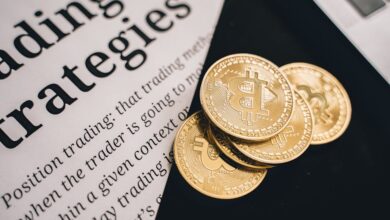Navigating the Gold ETFs Landscape: A Comprehensive Guide to Investing in Physical Gold and Market Trends

In recent years, the allure of gold as a safe haven asset has gained renewed attention, particularly with the complexities of today's financial landscape. As investors seek stability amid market volatility, gold exchange-traded funds (ETFs) have emerged as a prominent option, offering a convenient way to gain exposure to physical gold without the hassles of storage and security. This article delves into the multifaceted world of gold ETFs, exploring how they function as a viable gold investment and their role in the broader gold market trends. From analyzing the impact of fluctuating gold prices on ETFs to examining the interplay between physical gold, gold futures, and even cryptocurrency, we will uncover the nuances of investing in this precious metal. Additionally, we will consider the future of gold investment in the context of global gold demand, sustainable gold mining practices, and the ongoing shifts in the gold trade. Join us as we navigate the intricate landscape of gold ETFs, shedding light on their potential to enhance your investment portfolio while safeguarding your assets in uncertain times.
- 1. Understanding Gold ETFs: How They Function as a Safe Haven Asset
- 2. Analyzing Gold Market Trends: The Impact of Gold Prices on ETFs
- 3. The Future of Gold Investment: Balancing Physical Gold with Gold Futures and Cryptocurrency
1. Understanding Gold ETFs: How They Function as a Safe Haven Asset
Gold ETFs, or exchange-traded funds backed by physical gold, have emerged as a popular investment choice for those seeking a safe haven asset. Understanding how these funds function is crucial for investors looking to diversify their portfolios and hedge against economic uncertainty.
Gold ETFs primarily invest in physical gold bullion, which means their value is directly linked to gold prices. When investors buy shares of a gold ETF, they are essentially purchasing a stake in a fund that holds gold bars and coins in secure vaults. This structure allows investors to gain exposure to gold without the need to physically store the metal, making it a convenient option for gold investment.
One of the key reasons investors turn to gold ETFs during periods of economic turbulence is their historical performance as a safe haven asset. In times of inflation or currency devaluation, gold often retains its value, functioning as a hedge against financial instability. As central banks around the world increase their gold reserves, many view gold as a reliable store of value, reinforcing its status in the gold market trends.
Moreover, the liquidity offered by gold ETFs makes them attractive compared to other forms of gold investment, such as physical gold, gold coins, or gold jewelry. Investors can quickly buy or sell their shares on major exchanges, similar to trading stocks or gold futures, allowing for greater flexibility in managing their investment strategies.
In recent years, the global gold demand has also been driven by technological advancements in the gold industry. Innovations in sustainable gold mining and gold refining processes have contributed to a more responsible and ethical gold trade. This is particularly appealing to socially conscious investors who prioritize environmental sustainability alongside financial returns.
Additionally, the rise of gold recycling has created new opportunities for investors. As more individuals and businesses recycle old gold jewelry and collectibles, the supply of available gold bullion increases, impacting gold production and potentially influencing gold prices.
In summary, gold ETFs offer a unique investment vehicle that combines the benefits of physical gold with the convenience of modern trading. As a safe haven asset, they attract investors looking to navigate the complexities of the gold market while minimizing risk. By understanding how gold ETFs function and their role in the broader context of gold investment, investors can make informed decisions that align with their financial goals.
2. Analyzing Gold Market Trends: The Impact of Gold Prices on ETFs
The relationship between gold prices and gold ETFs is crucial for investors seeking exposure to the gold market. As a safe haven asset, gold typically sees increased demand during periods of economic uncertainty, which directly influences the performance of gold ETFs. Analyzing gold market trends can provide valuable insights into potential price movements and investment opportunities.
Gold prices are affected by various factors, including inflation rates, central banks' gold reserves, and geopolitical events. For instance, when inflation rises, the demand for gold often increases, as investors turn to gold as a hedge against losing purchasing power. This surge in demand can lead to higher gold prices, subsequently boosting the value of gold ETFs that are backed by physical gold.
Moreover, fluctuations in gold production and gold recycling can also impact the gold market. This includes the output from gold mining operations and the availability of scrap gold from jewelry or other sources. Analyzing these elements can help investors understand supply dynamics and how they might influence gold prices in the short and long term.
Another aspect worth noting is the growing global gold demand, driven by emerging markets and the increasing popularity of gold collectibles, such as gold coins and jewelry. As more investors seek to diversify their portfolios with gold investments, gold ETFs become an attractive option, offering a convenient way to gain exposure without the need for physical storage.
Furthermore, the rise of gold futures and the introduction of gold and cryptocurrency investments have created new avenues for traders and investors alike. These developments can lead to increased volatility in the gold market, making it essential for investors to conduct thorough gold market analysis before entering positions in gold ETFs.
In conclusion, the interplay between gold prices and gold ETFs is shaped by a multitude of factors, from central banks' gold strategies to global demand changes. Understanding these dynamics can help investors make informed decisions in the ever-evolving landscape of gold investment.
3. The Future of Gold Investment: Balancing Physical Gold with Gold Futures and Cryptocurrency
As we look to the future of gold investment, it becomes increasingly important to understand how various forms of gold assets can complement each other. Investors are now balancing traditional physical gold, such as gold bullion and gold coins, with innovative options like gold ETFs and gold futures. This diversification is crucial as the gold market continues to evolve amid fluctuating gold prices and changing global market trends.
Physical gold remains a safe haven asset, sought after during times of economic uncertainty. Its tangible nature provides a sense of security that intangible assets cannot match. However, the emergence of gold ETFs has made it easier for investors to gain exposure to gold without the challenges of storing and securing physical gold. Gold ETFs are particularly appealing for those looking to capitalize on gold market trends without the need for direct ownership.
On the other hand, gold futures offer traders a way to speculate on gold prices and hedge against market volatility. As the gold market shifts with economic indicators, including inflation and changes in central banks' gold reserves, futures contracts can provide strategic opportunities for profit.
Moreover, the rise of cryptocurrency has introduced a new dynamic in the gold investment landscape. Many investors are now exploring the relationship between gold and cryptocurrency, recognizing that both can serve as protection against inflation and economic instability. While cryptocurrencies present unique risks, they also offer the potential for high returns, appealing to a younger demographic of investors who may not have previously considered traditional gold investing.
Sustainable gold mining practices are also gaining traction, reflecting a growing global demand for ethically sourced materials. Investors are now more conscious of the environmental impacts of gold production and are seeking investments that align with their values. This shift not only influences personal investment choices but also shapes the broader gold trade and market dynamics.
In summary, the future of gold investment will likely see a harmonious blend of physical gold, gold ETFs, gold futures, and even cryptocurrencies. By understanding the strengths and weaknesses of each asset type, investors can create a diversified portfolio that leverages the unique benefits of gold while adapting to the ever-changing landscape of the financial world. As global gold demand continues to evolve, staying informed about gold market analysis and trends will be essential for making informed investment decisions.
In conclusion, gold ETFs serve as a vital tool for investors looking to navigate the complexities of the gold market. As a safe haven asset, they offer a unique opportunity to gain exposure to physical gold without the burdens associated with storing and managing gold bullion or gold coins. By understanding how gold ETFs function, investors can make informed decisions that align with their financial goals, especially in today's volatile economic landscape marked by inflation and fluctuating gold prices.
The analysis of gold market trends reveals the intricate relationship between gold prices and ETFs, highlighting how these investment vehicles can be influenced by global demand and central banks' gold reserves. As we look towards the future of gold investment, the balance between physical gold, gold futures, and emerging assets like cryptocurrency will be crucial for portfolio diversification.
With the rise of sustainable gold mining practices and the importance of ethical sourcing, investors are increasingly aware of the implications of their choices within the gold trade. Whether you're considering gold jewelry, gold collectibles, or investing in gold coins, understanding the dynamics of gold ETFs can greatly enhance your investment strategy. As the gold market continues to evolve, staying informed about gold production, recycling, and refining processes will aid in making wise investment decisions. Ultimately, as global gold demand rises, gold ETFs will likely remain a significant player in the landscape of gold investment, providing a bridge between traditional assets and modern financial innovations.





